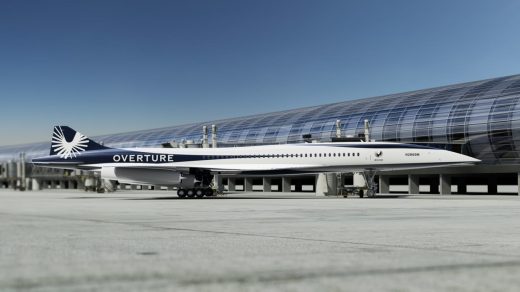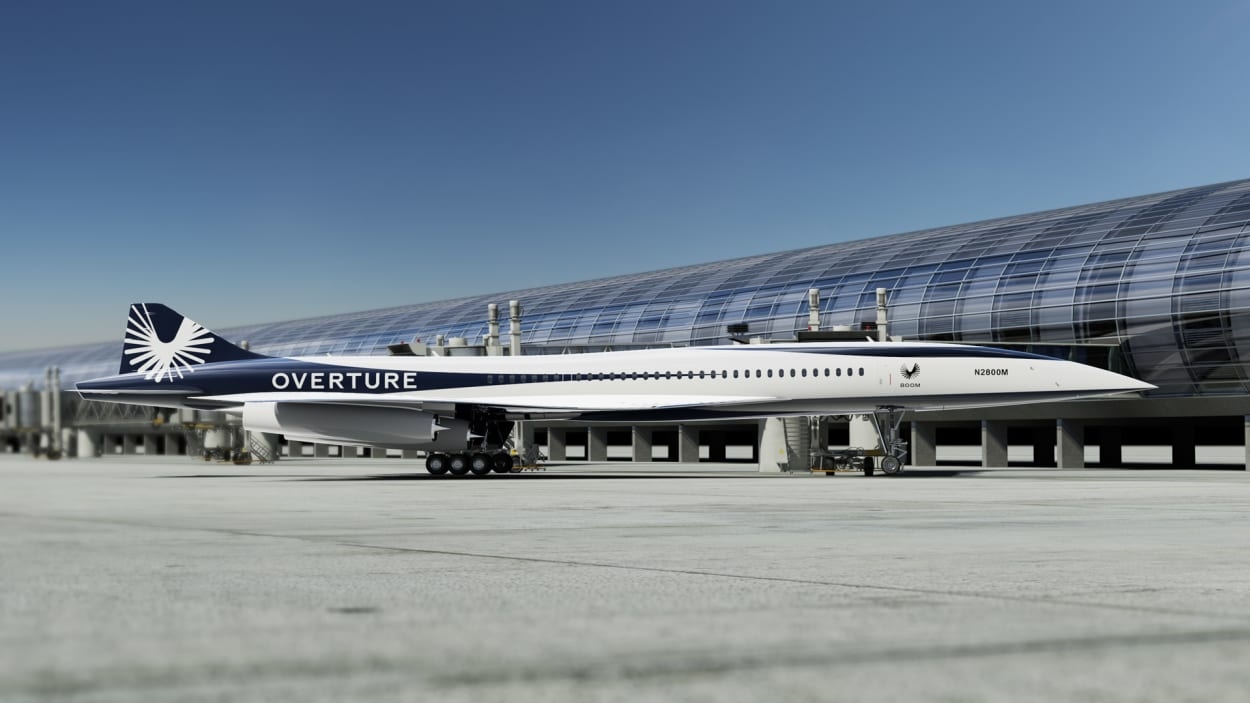Boom Supersonic reveals new partners and engine details, bringing its Mach 1.7 passenger jet closer to reality
By Tim Stevens
It can take a long, steady ground roll to get a big airplane up to speed, and for Boom Supersonic, the path off the runway is starting to look a little clearer. At the Paris Auto Show this week, the aerospace startup announced a slew of partners for the construction of major components of its aircraft, marking another significant step towards its goal of bringing supersonic air travel to the masses—or, at least, the wealthiest subset of the masses.
Additionally, Boom is showing off new details of its Symphony engine, literally the driving force behind its Overture airliner—and one of the more troublesome components for the aviation startup that’s working to commercialize international overseas flights at Mach 1.7, roughly halving the duration of popular routes like New York to London and Seattle to Tokyo.
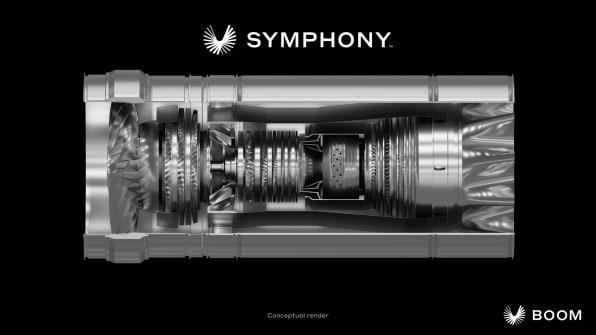
The development of Symphony has been key for Boom, which in 2020 struck a deal with Rolls-Royce to help develop Overture’s engine. But, Rolls-Royce ultimately walked away from the project two years later, saying that the commercial supersonic sector simply “is not currently a priority.”
It was an ominous development, but Boom founder and CEO Blake Scholl saw a silver lining: “We made a strategic decision that we wanted to own and control the design of the engine,” Scholl tells Fast Company, “and this is something that you see really every successful new entrant in aerospace doing. Who built SpaceX‘s engines? SpaceX does. Who builds Blue Origin‘s engines? Blue Origin does.”
Former Boeing CEO and current Boom advisor Phil Condit agrees. “When you’ve got a clean sheet of paper, you can do some pretty amazing things,” he said.
That engine design, though, will not come from in-house. Kratos Defense & Security Solutions subsidiary Florida Turbine Technologies, or FTT, is handling the design and initial production for Symphony. “In our view, this is the number one supersonic engine design team on the planet,” Scholl says. “Many of the engineers previously developed the engines that power the F-22 and F-35. And additionally, they’ve worked on the core technology for large commercial engines.”
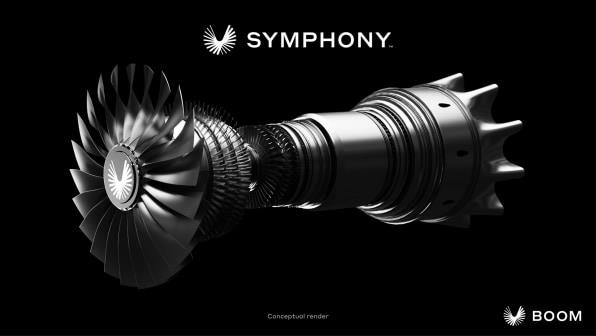
Kratos and FTT are joined by Spanish wing supplier Aernnova. Another Spanish company, Aciturri, will handle the construction of the Overture’s tail section, while Italian firm Leonardo will build the fuselage. All three are proven suppliers for major international aircraft builders like Airbus and Embraer.
These components will be married at Boom’s own factory in Greensboro, North Carolina, which is “right in the throes of construction,” Scholl says. “We are on track to be able to have that facility ready toward the middle of next year.”
These are major boxes to tick along Boom’s current plans to fly its Overture airliner by 2027, but other dates have been slipping.
The company’s test aircraft, the XB-1, was meant to fly by 2018. It still hasn’t left the ground. “So, we are taking safety extraordinarily seriously,” Scholl said. “And the test program is very methodical. It’s very step-by-step, and so we’re looking forward to the first flight later this year, and the first supersonic flight as soon as it’s safe to do so.”
That aircraft relies on three General Electric J85 engines, technology dating back to the 1950s. Boom’s Symphony engine will be radically different. The twin-spool turbo fans will make 35,000 pounds of thrust each without afterburners, enabling them to operate far quieter and more efficiently than the Rolls-Royce/Snecma Olympus 593 engines that powered the Concorde.
Crucially, Boom’s engine will be designed to run on sustainable aviation fuel, or SAF. This renewable fuel dramatically reduces carbon output compared to fossil fuels and is a huge part of how the overall aviation industry plans to remain relevant and viable in an increasingly environmentally conscious future.
Many airlines are relying on so-called book and claim SAF certificates, like carbon offset credits for jet fuel that allow airlines to support the production of SAF while still burning jet fuel of the traditional variety.
“For our own usage, we really are dedicated to using the actual SAF molecules,” Boom Supersonic’s VP of sustainability, Ben Murphy, told Fast Company. “So, for our flight test program from 2027 to 2030, for all customer deliveries, we’re working on the logistics of getting SAF to our production site in North Carolina.”
Global supplies of SAF simply don’t exist today, and availability will still likely be a challenge in the future. “The reality is, you know, 2030, 2035, we probably won’t see SAF at every global airport,” Murphy said. “And so that’s why it’s really important that we’re taking an active role in advancing the book and claim registries that enable a robust bookkeeping of SAF certificates.”
Iain Boyd, professor of aerospace engineering sciences at the University of Colorado, Boulder, sees this as crucial. “If the subsonic aviation sector is successful in introducing SAF at a meaningful level, then it is good economic and public relations strategy for Boom to include that in their planning,” he said. “With current SAFs that have been flown still costing three times more than regular jet fuel, however, it is not clear when SAFs will become a major fraction of the fuel consumed by all aircraft.”
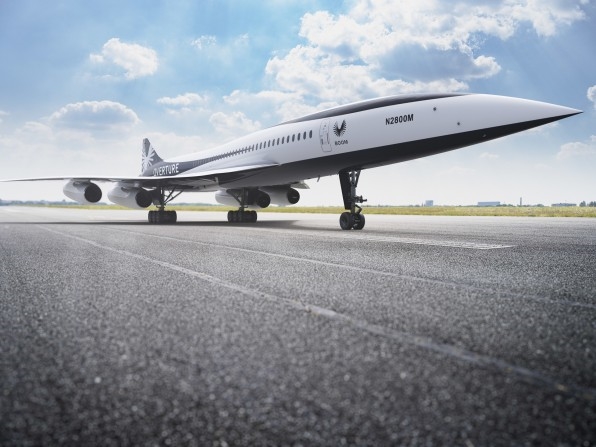
And, as aviation consultant Brian Foley points out, SAF is not an environmental panacea. “Burning any kind of fuel still produces emissions,” Foley said, “and activists would take the opportunity to call out jets with high CO2 emissions per passenger.”
Overture will seat between 64 to 80 passengers, compared to upwards of 300 on a Boeing 787. That, plus the additional fuel demands of going fast, means significantly higher fuel consumption than today’s subsonic jets. Boom’s Ben Murphy estimates that Overture will burn roughly two to three times as much fuel on a per-passenger basis.
There are also major financial barriers: “A new engine design can potentially be a multibillion dollar endeavor,” Foley says. And indeed, those barriers have proved insurmountable for other aviation startups, including Aerion Supersonic, which shuttered in 2021 after failing to raise the necessary capital to bring its supersonic private jet to production.
However, Boom’s Scholl doesn’t seem too concerned with Aerion’s failings. “Going toward a private jet, for one it’s a step away from a mainstream market; in my opinion it’s going in the wrong direction,” he said.
Boom’s Overture, on the other hand, is intended for commercial use. “The airlines know how to deploy this at scale on hundreds of routes around the planet,” he said.
Boom says that early orders from airlines like American, JAL, and United have come with a “significant, nonrefundable deposit.” If nothing else, that shows faith from some of the largest aircraft operators on the planet.
Still, more funding will be required. “This is a capital-intensive thing to go do,” Scholl conceded, but the goal is to sell “hundreds, if not thousands” of aircraft at $200 million each. “That’s a tall order, but if we succeed in that, we’ll have built one of the most valuable companies on the planet,” he said.
Boom’s jets may be running late, but Scholl’s optimism continues to soar.
(21)

